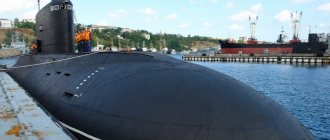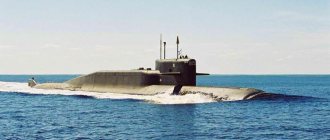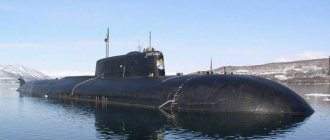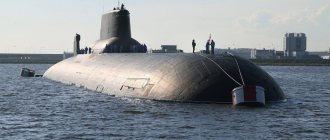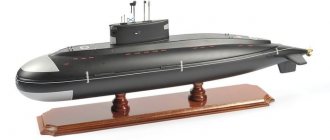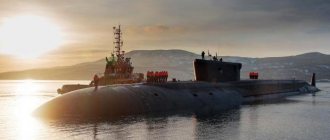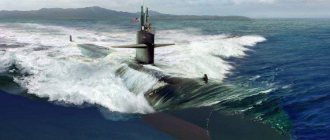Characteristics of Project 651 submarines (NATO: “Juliet”)
| A country: | USSR |
| Type: | Diesel-electric submarine |
| Date of issue: | 1963 |
| Displacement: | Surface - 3174 tons, underwater - 4137 tons |
| Length: | 90 m |
| Width: | 10 m |
| Draft: | 7 m |
| Reservations: | No |
| Crew: | 82 people (including 12 officers) |
| Power point: | 2x diesel engines (4000 hp each), 2x electric motors (6000 hp each), diesel generator (1720 hp), 2x electric motors 150 hp each. |
| Travel range: | 9000 miles at 8 knots surfaced, 810 miles at 2.74 knots submerged (on one battery charge). Autonomy - 90 days. |
| Maximum speed: | Surface - 19 knots, submerged - 14 knots. The normal diving depth is 240 m, the maximum is 360 m. |
| Weapons: |
|
| Air group: | No |
Literature
- A.E. Taras.
2nd generation 661 “Anchar” • 667AT “Pear” • 667M “Andromeda” • 670 “Skat” • 670M “Skat-M/Chaika” • 06704 “Chaika-B” 3rd generation project 949 “Granit” • project 949A “Antey” 4th generation 885 "Ash"
History of the creation of Project 651 submarines
Soviet diesel-electric submarines of Project 651 (according to NATO classification: “Juliett” - “Juliet”) entered service with the fleet in the late 1950s. These were unique ships of their kind - the first and only diesel submarines in the Soviet Navy, built specifically to be armed with cruise missiles with a nuclear warhead.
Unlike the nuclear-powered “Kitas” of Project 627, for which they tried to adapt actually existing land-based cruise missiles, each diesel missile carrier of Project 651 had 4 P-5 missiles (developed at the Chelomey Design Bureau), created specifically for submarines. The P-5 missiles were equipped with the ARK-5 folding wing system, which made it possible to launch the missile from a compact launcher with a relatively small diameter, ideal for the cramped conditions of a submarine.
Hull drawing of the Soviet diesel-electric submarine Project 651
The offensive armament of Project 651 submarines consisted of two types of nuclear missiles:
- P-5 cruise missiles, intended to destroy stationary coastal targets. The P-5 missile was not particularly accurate - the “error” of a hit was 3 km per 500 km of travel. But it carried an RDS-4 warhead weighing 930 kg, which compensated for any aiming inaccuracy.
- P-6 cruise missiles, intended to destroy naval maneuvering targets, primarily enemy aircraft carriers. This missile was controlled, to improve accuracy, its flight path could be adjusted not only by submarine personnel, but also by the crews of specially equipped Tu-16RTs and Tu-95RTs strategic bombers, or by the ship's Ka-25RTs helicopter.
Considering that at the time of their creation both missiles were very advanced and could easily “hack” the American air defense system - both ground and sea-based, the Juliet was supposed to be built on a grand scale: the initial order was as many as 36 pieces. However, due to the emergence of a more advanced version of the diesel-electric submarine Project 675 (a further development of Project 651, armed not with 4, but with 8 missiles), 16 submarines were built.
Model of a Project 651 submarine with open cruise missile launchers
Gallery
- Juliet-US-Navy-Photo.jpg
- Submarine Juliett class.jpg
Project 651 boat at sea
- U 461 1.jpg
B-24 as "U-461". Left side
- U 461 2.jpg
B-24 as "U-461". Nose
- U 461 3.jpg
B-24 as "U-461". Starboard
- U 461 4.jpg
Aft missile containers in firing position
- Peenemuende museum 15.jpg
"Russian submarine U-461 with cruise missiles"
- Peenemuende museum 16.jpg
Aft missile containers in firing position
- Peenemuende museum 17.jpg
- U 461 2592×1944.jpg
Design and modifications of Project 651 submarines
Diesel-electric submarines of Project 651 were very advanced ships at the time they entered service. Although their hulls were made of ordinary steel (the first 8 boats had an external, “light” hull made of low-magnetic steel, however, due to defects in the material, this was later abandoned), they were covered with a special sound-radio-absorbing coating made of hard rubber, which sharply reduced noise detection .
The silver-zinc rechargeable batteries were completely unique, allowing an underwater speed of up to 17.5 knots for 1.5 hours, and also providing an underwater range of 810 miles. Also, it was on one of the boats of Project 651 (on the K-81) that the Kasatka-B navigation system was used for the first time, receiving information about targets from satellites.
Project 651 submarine on the surface
The Project 651 diesel-electric submarines had a double-hull design with an exceptionally large reserve of buoyancy. The robust (internal) case consisted of eight compartments:
1. Bow torpedo compartment.2. Living quarters and front battery compartment.3. Compartment for missile control and batteries.4. Control compartment.5. Living quarters compartment and two groups of rechargeable batteries.6. Compartment with diesel engines and diesel generator.7. Electric motor compartment.8. Aft torpedo compartment.
Almost all personnel were provided with sleeping places (a big step forward compared to previous projects). The missile carriers were equipped with general ship ventilation systems, electric heaters, steam batteries, and refrigerators. The free space has increased, including due to the removal of missile launchers from the durable hull into the inter-hull space (in front of and behind the wheelhouse fence).
In addition to the base model, there were 2 modifications of Project 651 diesel-electric submarines:
- Project 651K is a basic missile carrier (K-81) with a satellite antenna for receiving target designations from military satellites, and the Kasatka-B control equipment complex.
- Project 651E - in 1985, already at the end of the life of submarines of this type, their “magic” silver-zinc batteries, due to the exhaustion of their service life, were replaced with conventional lead ones. This did not benefit the already old ships, so on the basis of the K-68 missile carrier, an experiment was carried out to install an auxiliary nuclear power plant. A unique miniature nuclear reactor was created especially for these purposes. Like the missile launch containers, it was placed in the space between the hulls, in the stern of the boat. The characteristics of the ship, and especially the underwater time, predictably increased and the experiment ended in complete success. However, taking into account the high cost and complexity of re-equipment (and the presence of more advanced and new ships in the fleet), the “nuclear-diesel-electric submarine” remained in a single copy.
One of the “Juliettes” of project 651
Current status
14 out of 16 boats were scrapped. The remaining two were sold abroad: the B-24 was sold to Germany in 1994. Used as a museum with incorrect designation U-461
on the body. As of 2010, it is the only one surviving. The B-77 was sold to a Finnish businessman who built a restaurant in it, then resold to an American company and towed to the USA. Since 1997, the boat has been used as a tourist attraction in the city of St. Petersburg, Florida, USA. In 2000-2001 she starred as K-19 in the film of the same name, and from 2002 to 2007 she was an exhibit at a museum in the city of Providence as part of the museum of the aircraft carrier Saratoga. A red star and the designation U-484 were painted on the wheelhouse. As a result of a storm on April 17, 2007, she was damaged and sank the next day. Raised only 15 months later, repairs were estimated at $1 million, which were never found, so in May 2010 the boat was cut up for scrap.
Notes
- ↑ 1 2
SUBMARINE PR.
651 (undefined)
. book.uraic.ru/elib/pl/. Access date: October 8, 2007. - ↑ 1 2
Submarine K-77.
Project history (unspecified)
(inaccessible link). www.k-77.com. Access date: October 8, 2007. Archived December 9, 2011. - previously it was taken into account that part of the crew was on watch, so there were fewer sleeping places than people
- Auxiliary nuclear power plant VAU-6 - Russian version of an air-independent power plant for diesel submarines
- History of the creation and trial operation of the Project 651E submarine with the VAU-6 auxiliary nuclear power plant. I. V. Ivanov. Page 28
- Project 651 (NATO - Juliett) (unspecified)
(unavailable link).
2003-2004
. ruspodlodka.narod.ru. Access date: October 8, 2007. Archived July 14, 2010. - S. Aprelev “Metamorphoses of K-77”
- K-77 — Submarine K-77
- K-77, B-77, “U-484” project 651, deepstorm.ru
- K-81 modified according to project 651K.
- K-58, B-58 project 651
Representatives
In total, it was planned to build 36 boats, but the series was limited to 16 ships. The two main ones were built at the Baltic Shipyard in St. Petersburg, the rest - at Gorky.
| Name | Place of construction | Serial number[6] | Bookmark date | Date of descent | Date of entry into service | Fleet | Notes |
| K-156 | Baltic plant | 552 | November 16, 1960 | July 31, 1962 | December 10, 1963 | Northern Fleet, since 1977 - renamed B-156, transferred to the Baltic Fleet | scrapped in 1988 |
| K-85 | Baltic plant | 553 | October 25, 1961 | January 31, 1964 | December 30, 1964 | Northern Fleet, since 1977 - renamed B-124, transferred to the Baltic Fleet | scrapped in 1988 |
| K-63 | "Krasnoe Sormovo" | 513 | April 25, 1962 | July 26, 1963 | December 31, 1964 | Pacific Fleet, since 1977 renamed B-63 | scrapped in 1991 |
| K-70 | "Krasnoe Sormovo" | 514 | March 25, 1962 | February 6, 1964 | December 31, 1964 | Pacific Fleet, since 1987 renamed B-270 | scrapped in 1991 |
| K-24 | "Krasnoe Sormovo" | 511 | October 15, 1961 | July 15, 1962 | October 31, 1965 | Northern Fleet, since 1977 - renamed B-24, transferred to the Baltic Fleet, | sold to Germany in 1994, exhibited in Peenemünde as U461 |
| K-68 from 1977 B-68 from 1990 BS-68 | "Krasnoe Sormovo" | 512 | January 25, 1962 | April 30, 1963 | December 28, 1965 | Northern Fleet, since 1977 Baltic Fleet | In 1985 it was modernized according to project 651E. In 1992 it was transferred to the reserve and put into storage, in 2004 (or 2005?) it was transferred for disposal in the Murmansk region. |
| K-77 | "Krasnoe Sormovo" | 515 | January 31, 1963 | March 11, 1965 | October 31, 1965 | Northern Fleet, since 1977 - renamed B-77, transferred to the Baltic Fleet, | sold to Finland, then to the USA[7], in 2000-2001 she starred as K-19 in the film of the same name, then for about 5 years was used as a museum in the city of Providence (the capital of the American state of Rhode Island), April 18, 2007 sank[8], raised in July 2008, restoration of the museum was estimated at $1 million. No money was found, and in May 2010 the boat was cut into scrap metal.[9] |
| K-81[10] | "Krasnoe Sormovo" | 522 | November 20, 1963 | August 7, 1964 | December 14, 1965 | Northern Fleet, since 1977 - renamed B-81, transferred to the Baltic Fleet in 1981, | Modified in 1971 or 1972 according to Project 651K. According to other sources, it was originally completed according to a modified project. Project 651K differed from the basic one in the presence of an antenna and equipment for space target designation of a cruise missile complex. In April 1991, she was withdrawn from combat service and laid up in the bay of Liepaja. Subjected to plunder of non-ferrous metals. In October 1991, she sank off the pier. In 1994, during the withdrawal of Russian troops from Latvia, it was abandoned in a semi-submerged state, later raised by a Latvian company and cut into metal. |
| K-58 | "Krasnoe Sormovo" | 521 | July 15, 1963 | December 1966 | September 23, 1966 | Northern Fleet, since 1977 - renamed B-58[11] | Sank while moored in 1992 and was scrapped. |
| K-73 | "Krasnoe Sormovo" | 523 | August 11, 1964 | May 31, 1966 | December 15, 1966 | Pacific Fleet, since 1977 - renamed B-73 | scrapped in 1991 |
| K-67 | "Krasnoe Sormovo" | 524 | January 31, 1965 | October 29, 1966 | September 30, 1967 | Black Sea Fleet, since 1977 - renamed B-67 | scrapped in 1994 |
| K-78 | "Krasnoe Sormovo" | 525 | July 25, 1965 | March 30, 1967 | January 11, 1967 | Northern Fleet, since 1977 - renamed B-478, transferred to the Baltic Fleet, | Withdrawn from combat service in 1994, abandoned in Latvia, subsequently cut up for metal |
| K-203 | "Krasnoe Sormovo" | 531 | December 25, 1965 | June 30, 1967 | December 2, 1967 | Northern Fleet, since 1977 - renamed B-203, transferred to the Baltic Fleet | scrapped in 1994 |
| K-304 | "Krasnoe Sormovo" | 532 | August 6, 1966 | January 24, 1967 | September 21, 1968 | Northern Fleet, since 1977 - renamed B-304 | scrapped in 1994 |
| K-318 | "Krasnoe Sormovo" | 533 | March 29, 1966 | March 29, 1968 | September 29, 1968 | Black Sea Fleet, since 1977 - renamed B-318 | scrapped in 1994 |
| K-120 | "Krasnoe Sormovo" | 534 | March 25, 1967 | July 11, 1968 | December 26, 1968 | Pacific Fleet, since 1987 renamed B-120 | scrapped in 1991 |
